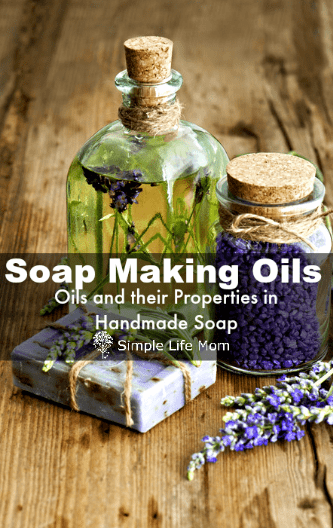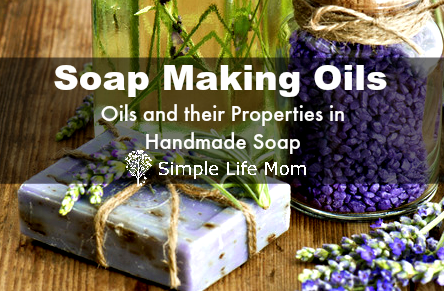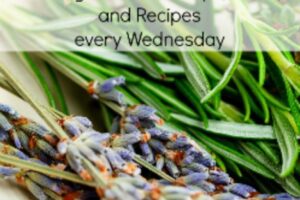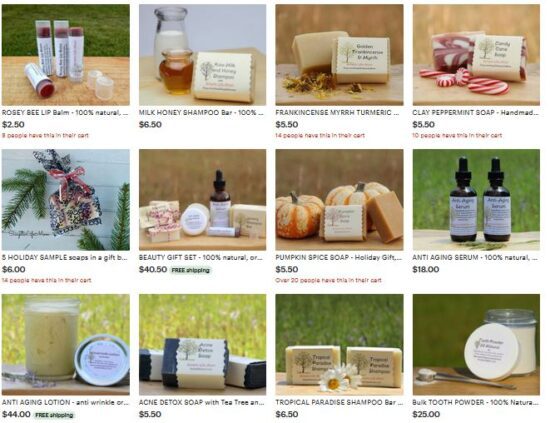Natural handmade soaps are wonderful for the skin and fun to make. If you’ve never made soap, just getting started, or are an experienced soap maker, it’s important for you to better understand which soap making oils are better for what you’d like to accomplish.
In other words, different oils bring different properties to soap.

I’ve had long, indepth discussions with other soap makers about what is left after saponification and how oils can impact the type of soap you can make.
After years of experience and research I’ve put together a list that I hope will help you better understand soap making oils and their properties so that you can begin to create your own recipes and know when a soap recipe has everything that you’re looking for.
How to Use this Soap Making Oils Chart
What happens when you have everything but one oil in a recipe?
Knowing which oils give hardness or moisture, conditioning, or creamy bubbles can help you replace that one oil you don’t have with another.
For example, if you don’t have coconut oil, but you know it adds cleansing power and hardness to your bar, you can find another oil that may help provide those properties as well. When you have one you’d like to try in its place you can go to a lye calculator, like on Soap Calc, and plug in the oils that you want to use and double check your numbers. You can also see what the predictions for your recipe are in the areas of cleansing, hardness, conditioning, etc.
You’re on your way to creating your own soap recipes!
Choosing a recipe that someone has already made is wonderful (Check out all of my recipes from THIS PAGE), but it’s also creative and fun to be able to put together your own recipes. The information below can help you choose which oils will give you the benefits you are looking for.
If moisturizing is your top priority, then you can learn which oils are highly moisturizing. If you want to make an anti aging face bar, like this one, that is high in vitamin A and linoleic acid, then choose those oils below. Combine those with hardening oils and oils that help with bubbliness and you are on your way to creating your own soap recipes for cold process soap making or hot process soap making.
Soap Making Oils, Fats, and Butters
There are, of course, many other oils that you can use. These are very popular oils that soap makers often choose to use due to their valuable properties.
Apricot Kernel Oil
Properties: Highly Conditioning, Moisturizing, Stable Creamy Lather
High in vitamin A, C, E, linoleic and oleic acids. Too much can make soap too soft.
Argan Oil
Properties: Conditioning, Moisturizing, Adds Hardness, Stable Rich Lather
High in vitamin A and E and antioxidants.
Avocado Oil
Properties: Conditioning, Medium Creamy Lather
High in vitamins A, B, D and E oleic and palmitoleic acids.
Babassu Oil
Properties: Cleansing, Adds Hardness, High Bubbles
High in vitamin E and antioxidants like phytosterols.
Castor Oil
Properties: Conditioning, Moisturizing, Creamy Lather with High Stable Bubbles.
90% ricinoleic acid, which has traditionally been used to help heal skin conditions.
Cocoa Butter
Properties: Conditioning, Moisturizing, Adds Hardness, Stable Rich Lather
High in vitamin E and other antioxidants. It doesn’t fully saponify, so it lends more of its properties to soap after curing.
Coconut Oil
Properties: Cleansing, Adds Hardness, High Lather with High Stable Bubbles
Coconut can be drying if it is over 45% of total oils in a soap IF you do not compensate by increasing the superfat content. it makes a wonderful cleansing, hard bar with great bubbles.

Grapeseed Oil
Properties: Highly Conditioning, Creamy and Stable Lather
High in lioleic acid, omega 6 fatty acids, and antioxidants.
Hazelnut Oil
Properties: Moisturizing, Cleansing, Stable Medium Lather
All around great oil for soap because it cleanses, moisturizes, and creates nice bubbles.
Hempseed Oil
Properties: Highly Conditioning, Low Lather
High in vitamins A and E, but can go bad in soap faster than other oils. Use as 5% or less of total oils for a longer lasting bar.
Jojoba Oil
Properties: Conditioning, Moisturizing, Strong Stable Lather
Like beeswax and cocoa butter, it doesn’t fully saponify, leaving more to hydropylic (water loving) qualities to help moisturize dry skin.
Lard
Properties: Conditioning, Adds Hardness, Stable Creamy Lather
Makes a great, long lasting bar. Make sure to choose a free-range, natural source.
Macadamia Nut Oil
Properties: Conditioning, Adds Hardness, Creamy Lather
High in antioxidants, oleic acid, omega 3 and omega 6 fatty acids.
Mango Butter
Properties: Conditioning, Moisturizing, Adds Hardness, Creamy Lather
High in Vitamin A and C and antioxidants.
Neem Oil
Properties: Conditioning, Moisturizing, Adds Hardness, Stable Creamy Lather
Calming, gentle oil used in soaps as an anti-inflammatory and anti-bacterial oil.
Olive Oil
Properties: Very Conditioning, Low Cleansing
Gentle oil with little cleansing properties, but high in antioxidants (Vitamin E and polyphenols). Makes a very soft soap and is best paired with a harder fat or oil.
Shea Butter
Properties: Conditioning, Adds Hardness, Stable Lather
Gives a silky feeling to bars. High in vitamins A and E, fatty acids and minerals.
Sweet Almond Oil
Properties: Stable Medium Lather
Gentle on the skin, Has vitamin A and E and oleic and linoleic acid.
Tallow
Properties: Conditioning, Cleansing, Adds Hardness, Stable Creamy Lather
All around great ingredient for soap making. Makes a great, long lasting, cleaning and bubbly bar. Make sure to choose a free-range, natural source.






89 Comments
Leave your reply.